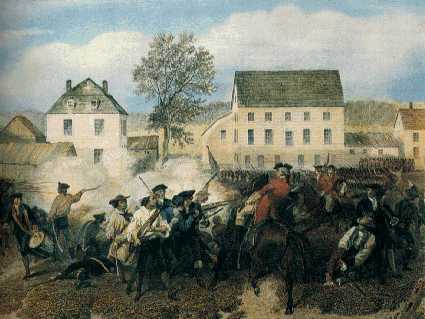| Ft. Ticonderoga as seen from Mount Defiance |

En route to Ticonderoga, Arnold received a bit of discouraging news. He was to be joined by another commander, the famous Ethan Allen. Arnold would no longer be the Brigadier to his recruits but would be co-commander of any troops raised. In truth, Allen was more veteran in both experience and rank. Allen had been fighting for years in the Vermont-New York Grants war where Allen had lead the Green Mountain Boys, a crack unit of some of the harshest and crudest mountain-men patriots the fledgling US had to offer. These men had grown up in the back woods, making their living as trappers, hunters, loggers and farmers. They were used to the territory and most had weapons that had been tested in combat against the encroaching New Yorkers. They now served the US but more importantly, they served Allen.
 |
| Flag of the Green Mountain Boys Militia |
To add insult to injury, Arnold, who had hoped to recruit 400 men, arrived with himself and two other men who had set out with him. They joined ranks with Allen and a little over 100 Green Mountain Militia. Allen became the default leader of the group and Arnold knew it.
After preliminary scouting, Allen found out that the fort was garrisoned by only a handful of troops whose powder had been ruined by the heavy rainfall and whose ammunition had dwindled to shockingly low levels. He was also able to gather inteligence that the British were to be reinforced any day by a force of unknown size. The time to act was upon them. he two leaders laid out plans to assault the fort. Arnold suggested a bold attack, but was quickly countermanded by Allen who dismissed Arnold's ideas as foolish and glory seeking. They settled on their best strategy, a sneak attack on the garrison at three points along the fort.
 |
| Modern view of Ticonderoga |
Within minutes the fort had been taken without a shot fired. The only recorded casualty was a slight wound suffered by an american who had tried to wrest a rifle from one of the sentries on guard duty. Quickly the fort filled with over 400 men who began looting and pilfering anything that was not bolted down. Arnold tried to stop it all and when he saw that he could not, he retired to the captain's quarters and began to write his action report. Allen, who was now seeing to the transportation of the over 30 artillery pieces entered the quarters and inquired as to the nature of the document at which Arnold was feverishly writing. When the reply came that it was an action report, Allen snatched the page, glanced over it and burned it in the fireplace declaring that it was his right, as commanding officer to detail the actions of the day. It is no doubt then, to see why Allen was hailed as the hero of Ticonderoga and Arnold was largely marginalized in the dispatches back to Congress.
This would not be the last time Arnold would be snubbed where credit was due.




















